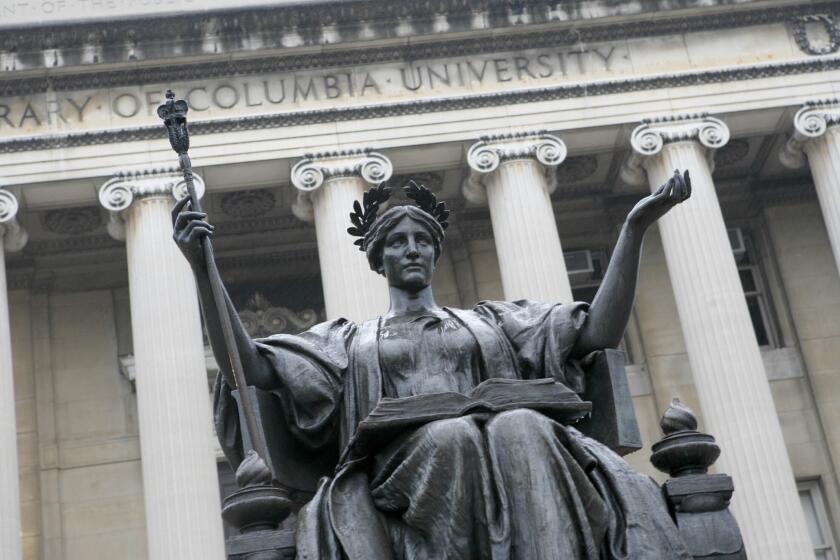After-school center serves diverse clientele
Five days a week after school, a number of middle-school students who live in Koreatown head for the Koreatown Youth & Community Center before going home.
There, inside a clean and well-lighted classroom decorated with posters about how to get into college and why it’s important to eat healthful foods, they share a snack of fruit and bottled water and socialize for a bit before hitting the books.
Most of the kids are not Korean.
Self-respect and respect for one another’s heritage are encouraged at the center, founded in 1975 as the Korean Youth Center to serve Korean immigrants. Today, a majority of families served by the agency are Latino, reflecting Koreatown’s demographics: 65% Latino, 25% Korean and 10% white, black and South and Southeast Asian.
Many of the instructors also bring to the center a heritage other than Korean -- 65% of the 80-member staff is non-Korean.
Johng Ho Song, the center’s executive director, has been with the agency for 23 years. Adjusting to the huge demographic changes while respecting the history of the organization has been challenging, he said.
“We had to go through a cultural shift,” Song said. “It took seven years and two name changes.”
The name was changed to Korean Youth & Community Center after the 1992 riots, then to its current name in 2004.
On a recent Tuesday, Gerardo Sanabria and Joshua Goag, seventh-grade classmates at Pio Pico Middle School, arrived 20 minutes early to play chess until Jessica Estrada, one of two instructors assigned, signaled the end of the social period at 3:30 p.m. and announced that it was time to do homework.
“A lot of families are immigrant families, so it’s difficult for them to help their kids with homework,” said Hae Jung Cho, the center’s director of development, explaining the value of the 2 1/2-hour after-school program.
Estrada and a second instructor, Chheav Em, are ever ready to help not only with homework but with computers and preparing for tests, such as the PSAT.
Sometimes, they also offer a sympathetic ear.
Being children of immigrants themselves -- Estrada’s family is from Guatemala and Em’s from Cambodia -- they understand what the youngsters are going through. It wasn’t that long ago that they, too, were there.
They handle the adolescents in their charge with warmth, humor and firmness.
When a boy doing his homework uttered “hell,” Estrada immediately called him on it.
“Sorry,” he said with a sheepish smile, as he looked around the room for his friends’ reaction. They smiled.
Among the posted rules in the room is one prohibiting “bad language.”
The young teachers also practice time management with individual students.
Recently, two students from John Burroughs Middle School were permitted to use the 60-minute homework time to read because they had done their homework before they came.
Eynar Martinez, an eighth-grader, read “A Child Called It,” while Jeffrey Jin, a sixth-grader, chose “The Little Prince.”
“I am going to read English first, then Korean,” he proudly told Estrada, showing her the book, which told the tale in both languages.
Similar ethnic pride was evident in Latino students. They often spoke to Estrada in Spanish, but addressed Em in English.
Heirs of dual heritages, Latinos and Koreans conversed in English and their ancestral languages as naturally as they breathed the air.
Elvis Mendoza -- his father is a Presley fan -- did homework while nursing a sore neck with a plastic bag of ice.
“I got hurt playing soccer,” he said, shrugging.
Sometimes, Elvis put the ice pack on his head, making it appear, from a distance, as if he were sporting a funny-looking hat.
“Middle school is a tough time because this is the time when the youngsters are developing self- identity,” said Song, who started as a peer counselor and has a psychology degree from UCLA.
Song said the need for structured after-school programs is great.
“Koreatown is one of the densest and poorest neighborhoods in the city and county of Los Angeles,” Cho said. “People don’t think of Koreatown as a neighborhood where families live, but thousands of families with kids live in Koreatown.”
In addition to the middle school program, which has 18 students between the ages of 11 and 14, the center also offers an after-school activity for about 40 elementary pupils at another site on Wilton Place.
When asked if they liked coming to the center, some nodded. But Eynar said “sometimes.” This month, he and his friends are busy being photographers. They’re scouring the neighborhood to capture their favorite shots of Koreatown, which they will submit to the Korean American Museum as a class project.
And, on Friday afternoons, they take a break from homework just to gab.
Called Teen Talk, the sessions have boys and girls meet separately.
“I grew up here and went to some of the same schools they went to, so I understand that they can’t talk to their parents” about some things that bother them, Estrada said. “We try to help fill the void.”
The annual Holiday Campaign is part of the Los Angeles Times Family Fund, a fund of the McCormick Tribune Foundation, which this year will match every donation at 50 cents on the dollar.
Donations are tax-deductible. For more information, call (213) 237-5771. To make credit card donations, visit latimes .com/holidaycampaign.
To send checks, use the attached coupon. Do not send cash. Unless requested otherwise, gifts of $50 or more are acknowledged in The Times.
More to Read
Start your day right
Sign up for Essential California for news, features and recommendations from the L.A. Times and beyond in your inbox six days a week.
You may occasionally receive promotional content from the Los Angeles Times.






